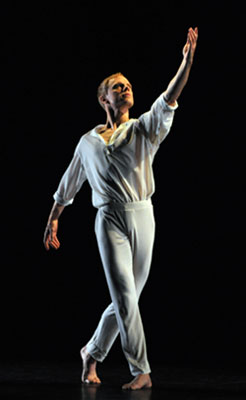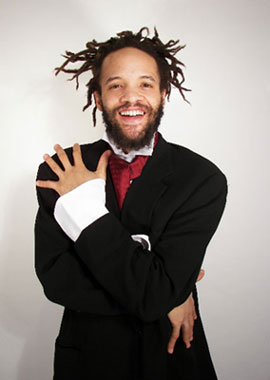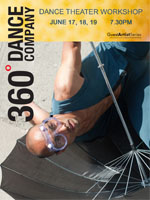Seeing Things: March 2009 Archives
Juilliard Dances Repertory / Peter Jay Sharp Theater, NYC / March 25-29, 2009
Consider what I'll call the minor leagues of dance performance--the shows put on by the best schools and junior companies honing advanced-level students who are talented; absurdly young, considering the skills they've developed; thoroughly rehearsed and coached; still ingenuous enough to lay their lives on the line for these events so essential to their upcoming careers as full-fledged professionals. Of the groups in New York alone, think ABT II, Ailey II, Taylor 2 (these first three have a busy touring life), the New York City Ballet-affiliated School of American Ballet, and the group from Juilliard that I saw just the other day in a program named Juilliard Dances Repertory. The showings produced by these institutions turn out to be not minor league at all and not merely showcases of the stars of the future, but usually very satisfying dance events in themselves.
Photo: Rosalie O'Connor
The Juilliard program opened with Mark Morris's Gloria (1981; revised 1984) to the eponymous Vivaldi score, staged by Megan Williams, an unforgettable Morris alum. Back in '81, I saw the premiere and was duly astonished by the genius of the work that illuminated the old Dance Theater Workshop auditorium, then a grungy black hole of a theater. Without any arty posturing, the choreography evoked the idea of humankind's capacity, despite its physically and spiritually crippled aspects, to aspire to glory. It conveyed its subject in such pared-down yet infinitely inventive ways, with such insightful musicality and command of structure, it looked as if Morris had reinvented dancing. Nearly three decades later, that startling newness hasn't worn away.
Of course the Juilliard dancers were at a certain disadvantage. The piece wasn't created on them; they lack the extreme diversity of body type and the strong and varied stage personalities that derive from that, so important to the early Morris ensemble. They also have the air of trying to live up to a model they've never seen. All this is inevitable in such a situation but, despite it, they were fearless and beautiful.
In a signature image, they ran at daring speed to crash to the floor, prone, with such force they skidded forward and then propelled themselves on their arms alone, dragging the rest of their now-inert body, and, a moment later, stood exultantly erect, arms reaching for the heavens, fingers waving with the adolescent exuberance of cheerleaders shaking their pompoms for their team or, just perhaps, for the greater glory of God. They had grasped a secret Morris has continued to examine, in myriad ways, throughout his career: the fact that the plebian and the sacred are one.
Photo: Rosalie O'Connor
Lar Lubovitch's 1978 North Star, to Philip Glass music, is the most telling example of this choreographer's treating a bevy of bodies as a single, magically fluent organism. Dancers clad in loose black garments cling loosely to one another on a night-dark stage, illuminated only by slim shafts of down-light. They join as a group, then as two quartets, to waft fluently like seaweed in an ocean that can turn turbulent or tender. A vehemently spasmodic solo--seemingly for a prophetess destined, ominously, to be ignored or scorned--punctuates the pacific mood for no discernable reason, but it balances the piece with some welcome rootedness and weight.
North Star was very well staged by Peggy Baker and John Dayger; the Juilliard dancers did them proud. In an age when "edginess" and inscrutability reign in dance, it must be a treat for them to be simply, liquidly, romantically lyrical.
Photo: Rosalie O'Connor
Twyla Tharp's original company was all female, and the tough-spoken choreographer ironically referred to the group as "a bunch of broads doing god's work." Her 1970 The Fugue was originally choreographed for three of these women (Tharp, Sara Rudner, and Rose Marie Wright); today it is often given to a trio of men. The Juilliard performances, staged by former Tharp dancers Jennifer Way and Tom Rawe, alternated the genders on alternate evenings.
I got to see the guy version, which I've always found somewhat disappointing, because it lacks the thrill of women attacking material that is as tough and emphatic physically as it is mentally. (This material consists of 20 intricately manipulated variations on a 20-count theme. The Fugue has no score beyond the percussive beat of the feet in heavy-heeled shoes on the electronically amplified stage.) The Juilliard men, especially, were too tempered and even-toned; lacking the deadpan ferocity the choreography requires. The men wore workaday shirts and trousers, but I recall the original Tharp femmes as more exotic in black garb and calf-high leather boots that meant business.
Still the dance is a marvel. You can almost hear Tharp's brain ticking away while her sense of theater gives the brilliantly engineered material color and excitement.
Only the final number on the program was a mistake. Batsheva Dance Company's director Ohad Naharin's From MAX and THREE (excerpts with a bit of reworking from two of his earlier pieces, plus a section in which the dancers lined up to take their turns performing unimpressive party tricks) was hardly a "premiere," as it was advertised, from this Juilliard alum. It seemed to exist just to put a very large number of dancers on stage, perhaps charitably to use students who didn't get to be in the other pieces. Well and good, I suppose, but Naharin missed the opportunity to do something authentically spectacular with this crowd. The performers just looked crowded, underemployed, and in some cases, perhaps with the least experienced, at a loss to know what they were supposed to aim for.
Still, three significant pieces out of four is more than most professional companies offer at a single repertory performance in these tarnished times. As for the Juilliard students' freshness and eagerness to get things right, these qualities should be bottled and sold as an elixir.
© 2009 Tobi Tobias
Paul Taylor Dance Company / New York City Center, New York City / February 25 - March 15, 2009

As the ambitious season ran on, displaying choices from five decades of Taylor works, it became more and more obvious that this dance-maker's genius, his range, and his appetite for new territory are extraordinary, as is his ability to conjure up the most diverse moods and feelings from a dance vocabulary he has not found it necessary to revise or augment much over the years.
The full article appeared in Voice of Dance (http://www.voiceofdance.org) on March 13, 2009. To read it, click here.
Savion Glover: SoLo in TiME / Joyce Theater, New York City / March 3-22, 2009

His feet are large--size 12 E or thereabouts--and, in their pedestrian mode, can look heavy and clumsy. Don't kid yourself; they're the fleetest human pedals imaginable. In quiet little soliloquies, the faster they get, the more crisply and delicately they strike the floor. When they slam down bluntly, full strength, you feel that the glass on the theater's exit signs, luminous in the dark auditorium, is in danger of shattering.
The full article appeared in Voice of Dance (http://www.voiceofdance.org) on March 5, 2009. To read it, click here.
This article originally appeared in the Culture section of Bloomberg News on March 6, 2009.

Dancers from the Paul Taylor Dance Company, from left, Michael Trusnovec, Julie Tice, and Orion Duckstein take part in a performance of "Beloved Renegade" in New York on Nov. 21, 2008. Performances continue through March 15, 2009 at New York's City Center. Photographer: Wiley Price/Paul Taylor Dance Co. via Bloomberg News
March 6 (Bloomberg) -- Illuminated by a narrow shaft of light, a man in white with pale coloring stands in a pure classical pose, as contemplative as a marble statue. A sheer dark scrim rises to reveal the people that have figured in his life, from youth to death, making him the man he is. Accompanied by Francis Poulenc's "Gloria," the ensuing events take on a sacred air.
Paul Taylor's new "Beloved Renegade" was featured last Wednesday at the opening of his company's three-week season at New York's City Center. It's a tribute to Walt Whitman, the American poet whose free-verse "Leaves of Grass" celebrated his feeling of oneness with everything in the world -- people, grass, you name it.
The central figure, played with eloquence and restraint by Taylor's muse, Michael Trusnovec, walks and watches as much as he dances. He observes various aspects of love: young people, whose innocent sensuality is their birthright, reveling in movement that is both tender and forceful, to a mound of dying soldiers, one of whom Trusnovec kisses tenderly on the mouth by way of a farewell blessing. (Whitman tended soldiers in the Civil War and was probably gay or bisexual.)
Old, Familiar Games
Trusnovec also watches the rollicking buoyancy of a quintet of children, still free of the world's sorrows, at play in old, familiar games. He observes ecstatic adults celebrating love both as a community and as individual couples, as if the two forms of Eros were the same.
He witnesses the seemingly miraculous cure of a physically afflicted woman (Amy Young). Often the full ensemble members, simply dressed by Santo Loquasto in ice-cream colors, make gestures of worship and praise, emphasizing the idea that every aspect of life is holy.
The statuesque Laura Halzack plays Trusnovec's guide and sometime dancing partner, though an emotional distance between them is scrupulously maintained. She is his guardian angel, eventually leading him to his inevitable death. Just before the curtain falls, the man we saw first poised in noble verticality lies supine and still, as if in his grave, while the woman rotates unwaveringly beside him, one leg extended high and curved, protecting him in life's last passage.
Taylor came late to Whitman. Cottoning to the poet's belief in the unity of body and soul -- what choreographer wouldn't? -- he didn't go off and write embarrassing imitative poems. Instead, nearing 80, Taylor has choreographed an homage to Whitman and the poet's unconventional principles that is a masterwork only an artist of his mature experience could achieve. It needs only to be a little longer to be perfect. Jennifer Tipton's lighting is already perfect.
Through March 15 at 131 W. 55th St. Information: +1-212- 581-1212; http://www.nycitycenter.org.
© 2009 Bloomberg L.P. All rights reserved. Reprinted with permission.
Sitelines
AJ Ads
 360° Dance Company at DTW offers two socially relevant revivals, Jane Dudley’s solo “Time Is Money” (1932) and Mary Anthony’s “Devil in Massachusetts” (1952) as well as the World Premier of Artistic Director, Martin Lofsnes' "6-1".
360° Dance Company at DTW offers two socially relevant revivals, Jane Dudley’s solo “Time Is Money” (1932) and Mary Anthony’s “Devil in Massachusetts” (1952) as well as the World Premier of Artistic Director, Martin Lofsnes' "6-1".
AJ Blogs
AJBlogCentral | rssculture
Terry Teachout on the arts in New York City
Andrew Taylor on the business of arts & culture
rock culture approximately
Laura Collins-Hughes on arts, culture and coverage
Richard Kessler on arts education
Douglas McLennan's blog
Dalouge Smith advocates for the Arts
Art from the American Outback
Chloe Veltman on how culture will save the world
For immediate release: the arts are marketable
No genre is the new genre
David Jays on theatre and dance
Paul Levy measures the Angles
Judith H. Dobrzynski on Culture
John Rockwell on the arts
innovations and impediments in not-for-profit arts
Jan Herman - arts, media & culture with 'tude
dance
Apollinaire Scherr talks about dance
Tobi Tobias on dance et al...
jazz
Howard Mandel's freelance Urban Improvisation
Focus on New Orleans. Jazz and Other Sounds
Doug Ramsey on Jazz and other matters...
media
Jeff Weinstein's Cultural Mixology
Martha Bayles on Film...
classical music
Fresh ideas on building arts communities
Greg Sandow performs a book-in-progress
Harvey Sachs on music, and various digressions
Bruce Brubaker on all things Piano
Kyle Gann on music after the fact
Greg Sandow on the future of Classical Music
Norman Lebrecht on Shifting Sound Worlds
Joe Horowitz on music
publishing
Jerome Weeks on Books
Scott McLemee on books, ideas & trash-culture ephemera
theatre
Wendy Rosenfield: covering drama, onstage and off
visual
Public Art, Public Space
Regina Hackett takes her Art To Go
John Perreault's art diary
Lee Rosenbaum's Cultural Commentary
